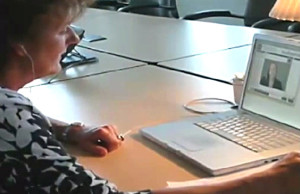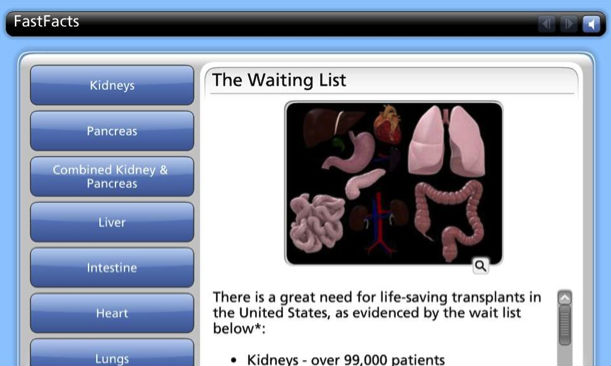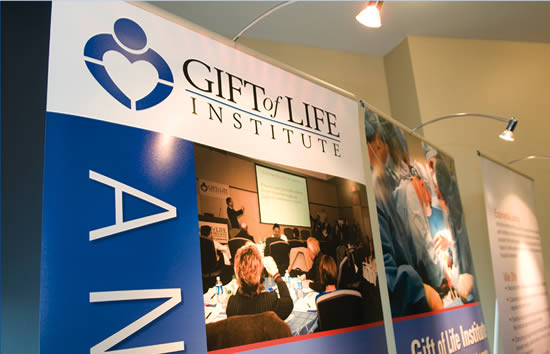Introduced by the Gift of Life Institute in 2017, The Art and Science of Leadership: Driving Results for Donation and Transplantation Professionals, is a multi-faceted certificate program specifically designed to address the needs of donation and transplantation professionals. The unique design of this course combines deep industry knowledge from leaders in the organ and tissue donation field with academic expertise from two of the world’s leading universities, the Aresty Institute of Executive Education at the Wharton School at the University of Pennsylvania, and Fox School of Business at Temple University.
Combining face-to-face learning, virtual classroom training, and one-on-one project plan mentoring from industry leaders, The Art and Science of Leadership is designed to help both emerging and experienced leaders master core business concepts and build key skills in:
- Transformational Leadership
- Change Management
- Talent Acquisition
- Performance Management
- Team Building
- Design Thinking
 We are privileged to have Mario Moussa as one of our lead instructors. Mario is a noted author, keynote speaker, and management consultant who advises senior leaders about top team effectiveness, organizational culture, and large-scale change initiatives. He has delivered workshops on leadership, strategic persuasion and collaboration to thousands of executives in New York, San Francisco, Beijing, Shanghai, Mumbai, Sao Paulo, London, Istanbul, and other major cities around the world. His work has been featured on National Public Radio as well as in leading publications, including Time Magazine, Business Week, U.S. News and World Report, Fortune, Forbes, Inc., Entrepreneur, The Economist, The Financial Times, and The Philadelphia Inquirer.
We are privileged to have Mario Moussa as one of our lead instructors. Mario is a noted author, keynote speaker, and management consultant who advises senior leaders about top team effectiveness, organizational culture, and large-scale change initiatives. He has delivered workshops on leadership, strategic persuasion and collaboration to thousands of executives in New York, San Francisco, Beijing, Shanghai, Mumbai, Sao Paulo, London, Istanbul, and other major cities around the world. His work has been featured on National Public Radio as well as in leading publications, including Time Magazine, Business Week, U.S. News and World Report, Fortune, Forbes, Inc., Entrepreneur, The Economist, The Financial Times, and The Philadelphia Inquirer.
With Mario’s permission, we share a video on “Providing Strength Through Culture and Networking” that he posted on his website.
For more information on the 2025 The Art and Science of Leadership program, either contract me directly at TDaly@giftoflifeinstitute.org or click here.
Over the past few years, a number of bestselling books have been written about how social media is impacting business in terms of giving all consumers of information a voice and level of influence in the perception of brands and the impact of a corporate message.
Among these, Trust Agents: Using the Web to Build Influence, Improve Reputation, and Earn Trust by Chris Brogan and Julien Smith, Tribes: We Need You to Lead Us by Seth Godin, and Groundswell: Winning in a World Transformed by Social Technologies by Charlene Li and Josh Bernoff, offer keen insights into the need for all organizations to participate in the social platforms that are affecting markets and perception.
The world of training is particularly impacted by social tools and changing dramatically—it used to be enough to have a podium or a position of acknowledged authority, so that audiences would pay attention. Now audiences expect more—they want to connect prior to an event, continue a dialog after a session, and even continue to participate and comment as training takes place.
The trend is obvious in all areas of presentation that the “expert” is no longer taken for granted as an authority figure. Among other factors, the “Backchannel”—or chatter among attendees during an event that can impact the attention and respect afforded a speaker—speaks to the new ways that audiences expect to be engaged, involved and treated with respect.
As the authors mentioned above point out, the key component of any information transaction today is creating value and providing a real benefit within the social landscape. Those who provide insight, value and, in some cases entertainment, gain influence, even over those who have previously been deemed authority figures. In the numerous examples described by these social media experts an individual or group can become a “Trust Agent,” create a “Groundswell” or become a “Tribe” by creating significant value through its engagement and communication through social tools like blogs, private and public social networks, viral video (on sites YouTube or Vimeo) and popular platforms like Twitter, Facebook and Google+.
Theresa A. Daly is Director of Gift of Life Institute in Philadelphia, PA.
 Earlier this year I had the opportunity to present at the 2014 Transplant Donation Global Leadership Symposium (GLS) on “21st Century Learning: Building a Learning-Oriented Culture in Transplant Donation.” I joined two colleagues including Gloria Páez of Transplant Procurement Management (TPM) who presented on new trends in the teaching role and technology applications and Maria Stadtler of Methodica, LLC (formerly of OneLegacy) who presented on customized training. My presentation was about eLearning and the principles that make it an excellent option for educating the donation professional.
Earlier this year I had the opportunity to present at the 2014 Transplant Donation Global Leadership Symposium (GLS) on “21st Century Learning: Building a Learning-Oriented Culture in Transplant Donation.” I joined two colleagues including Gloria Páez of Transplant Procurement Management (TPM) who presented on new trends in the teaching role and technology applications and Maria Stadtler of Methodica, LLC (formerly of OneLegacy) who presented on customized training. My presentation was about eLearning and the principles that make it an excellent option for educating the donation professional.
Dr. Ruth Clark, noted instructional psychologist, defines eLearning as “content and instructional methods delivered on a computer and designed to build knowledge and skills related to individuals or organization goals.” This simple definition defines:
The what: training delivered in digital format;
The how: content and instructional methods to help learners master the content, and:
The why: to improve performance by building job-relevant knowledge and skills.
Add to this definition three key elements that distinguish eLearning from other learning platforms: instructional methods, instructional media, and media elements.

Example from a Gift of Life Institute elearning module
I imagine some of you are asking: Instructional methods? Instructional media? Media elements? What does all this mean? These are the basic concepts you should consider when developing an eLearning module for your audience. Instructional methods, (e.g., practice exercises, simulations and analogies), are the techniques used to help the learner process new information. Instructional media are the delivery agents that contain the content, including workbooks, computers and instructors. And, finally, media elements refer to the graphics, text, audio and video used to present content and instructional methods. For example, in the screen at left, media elements include text, graphics and audio narration tied to specific organs.
While doing additional research, I came upon the work of Dr. Richard E. Mayer, a professor of psychology at the University of California, Santa Barbara. His research interests are in educational and cognitive psychology, and for the past 10 years, he and his team have been conducting controlled experiments on how best to use audio, text and graphics to optimize learning.
Dr. Mayer’s work concludes that six media elements are critical to successful learning.
- Multimedia: adding graphics to work improves learning. Use illustrations, line drawings, photographs, animation or video. It’s important to make sure the multimedia elements are consistent with the instructional message. For example, if you want to provide a visual on the number of people waiting in the United States for an organ transplant (124,000+), you might use a photo of a packed house at Michigan Stadium (seating capacity of 110,000).
- Contiguity: when graphics and text are aligned on the screen, the learner doesn’t have to work as hard to retain the material.
- Modality: explaining graphics with audio improves learning.
- Redundancy: research shows that learning is greater when graphics are explained by audio alone, rather than audio and text.
- Coherence: remember, less is more. Using gratuitous visuals and sounds can hurt learning.
- Personalization: use a conversational tone along with first and second person improves learning.
The 24 eLearning modules the Institute had developed thus far incorporated five of the elements Dr. Mayer identified. We do not fully embrace the personalization by using first or second person as independent research indicates that our learners prefer the use of somewhat more formal language. You would need to decide for your organization and learners if personalizing the modules in this manner is appropriate.
Whether you are developing the eLearning internally at your organization or looking to an outside source to assist you, I recommend you become familiar with the work of Dr. Mayer and his colleagues to help you in securing eLearning that will result in effective learning for your donation professionals.
Theresa A. Daly is Director of Gift of Life Institute in Philadelphia, PA


